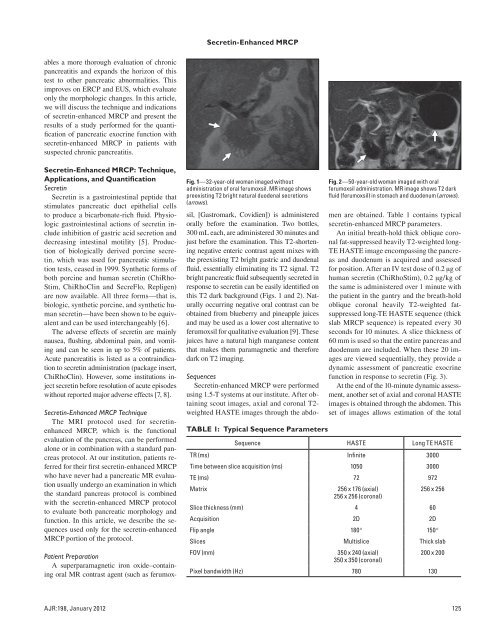Secretin-Enhanced MRCP: Review of Technique and Application ...
Secretin-Enhanced MRCP: Review of Technique and Application ...
Secretin-Enhanced MRCP: Review of Technique and Application ...
You also want an ePaper? Increase the reach of your titles
YUMPU automatically turns print PDFs into web optimized ePapers that Google loves.
<strong>Secretin</strong>-<strong>Enhanced</strong> <strong>MRCP</strong>ables a more thorough evaluation <strong>of</strong> chronicpancreatitis <strong>and</strong> exp<strong>and</strong>s the horizon <strong>of</strong> thistest to other pancreatic abnormalities. Thisimproves on ERCP <strong>and</strong> EUS, which evaluateonly the morphologic changes. In this article,we will discuss the technique <strong>and</strong> indications<strong>of</strong> secretin-enhanced <strong>MRCP</strong> <strong>and</strong> present theresults <strong>of</strong> a study performed for the quantification<strong>of</strong> pancreatic exocrine function withsecretin-enhanced <strong>MRCP</strong> in patients withsuspected chronic pancreatitis.<strong>Secretin</strong>-<strong>Enhanced</strong> <strong>MRCP</strong>: <strong>Technique</strong>,<strong>Application</strong>s, <strong>and</strong> Quantification<strong>Secretin</strong><strong>Secretin</strong> is a gastrointestinal peptide thatstimulates pancreatic duct epithelial cellsto produce a bicarbonate-rich fluid. Physiologicgastrointestinal actions <strong>of</strong> secretin includeinhibition <strong>of</strong> gastric acid secretion <strong>and</strong>decreasing intestinal motility [5]. Production<strong>of</strong> biologically derived porcine secretin,which was used for pancreatic stimulationtests, ceased in 1999. Synthetic forms <strong>of</strong>both porcine <strong>and</strong> human secretin (ChiRho-Stim, ChiRhoClin <strong>and</strong> SecreFlo, Repligen)are now available. All three forms—that is,biologic, synthetic porcine, <strong>and</strong> synthetic humansecretin—have been shown to be equivalent<strong>and</strong> can be used interchangeably [6].The adverse effects <strong>of</strong> secretin are mainlynausea, flushing, abdominal pain, <strong>and</strong> vomiting<strong>and</strong> can be seen in up to 5% <strong>of</strong> patients.Acute pancreatitis is listed as a contraindicationto secretin administration (package insert,ChiRhoClin). However, some institutions injectsecretin before resolution <strong>of</strong> acute episodeswithout reported major adverse effects [7, 8].<strong>Secretin</strong>-<strong>Enhanced</strong> <strong>MRCP</strong> <strong>Technique</strong>The MRI protocol used for secretinenhanced<strong>MRCP</strong>, which is the functionalevaluation <strong>of</strong> the pancreas, can be performedalone or in combination with a st<strong>and</strong>ard pancreasprotocol. At our institution, patients referredfor their first secretin-enhanced <strong>MRCP</strong>who have never had a pancreatic MR evaluationusually undergo an examination in whichthe st<strong>and</strong>ard pancreas protocol is combinedwith the secretin-enhanced <strong>MRCP</strong> protocolto evaluate both pancreatic morphology <strong>and</strong>function. In this article, we describe the sequencesused only for the secretin-enhanced<strong>MRCP</strong> portion <strong>of</strong> the protocol.Patient PreparationA superparamagnetic iron oxide–containingoral MR contrast agent (such as ferumox-Fig. 1—32-year-old woman imaged withoutadministration <strong>of</strong> oral ferumoxsil. MR image showspreexisting T2 bright natural duodenal secretions(arrows).sil, [Gastromark, Covidien]) is administeredorally before the examination. Two bottles,300 mL each, are administered 30 minutes <strong>and</strong>just before the examination. This T2-shorteningnegative enteric contrast agent mixes withthe preexisting T2 bright gastric <strong>and</strong> duodenalfluid, essentially eliminating its T2 signal. T2bright pancreatic fluid subsequently secreted inresponse to secretin can be easily identified onthis T2 dark background (Figs. 1 <strong>and</strong> 2). Naturallyoccurring negative oral contrast can beobtained from blueberry <strong>and</strong> pineapple juices<strong>and</strong> may be used as a lower cost alternative t<strong>of</strong>erumoxsil for qualitative evaluation [9]. Thesejuices have a natural high manganese contentthat makes them paramagnetic <strong>and</strong> thereforedark on T2 imaging.Sequences<strong>Secretin</strong>-enhanced <strong>MRCP</strong> were performedusing 1.5-T systems at our institute. After obtainingscout images, axial <strong>and</strong> coronal T2-weighted HASTE images through the abdo-TABLE 1: Typical Sequence ParametersFig. 2—50-year-old woman imaged with oralferumoxsil administration. MR image shows T2 darkfluid (ferumoxsil) in stomach <strong>and</strong> duodenum (arrows).men are obtained. Table 1 contains typicalsecretin-enhanced <strong>MRCP</strong> parameters.An initial breath-hold thick oblique coronalfat-suppressed heavily T2-weighted long-TE HASTE image encompassing the pancreas<strong>and</strong> duodenum is acquired <strong>and</strong> assessedfor position. After an IV test dose <strong>of</strong> 0.2 μg <strong>of</strong>human secretin (ChiRhoStim), 0.2 μg/kg <strong>of</strong>the same is administered over 1 minute withthe patient in the gantry <strong>and</strong> the breath-holdoblique coronal heavily T2-weighted fatsuppressedlong-TE HASTE sequence (thickslab <strong>MRCP</strong> sequence) is repeated every 30seconds for 10 minutes. A slice thickness <strong>of</strong>60 mm is used so that the entire pancreas <strong>and</strong>duodenum are included. When these 20 imagesare viewed sequentially, they provide adynamic assessment <strong>of</strong> pancreatic exocrinefunction in response to secretin (Fig. 3).At the end <strong>of</strong> the 10-minute dynamic assessment,another set <strong>of</strong> axial <strong>and</strong> coronal HASTEimages is obtained through the abdomen. Thisset <strong>of</strong> images allows estimation <strong>of</strong> the totalSequence HASTE Long TE HASTETR (ms) Infinite 3000Time between slice acquisition (ms) 1050 3000TE (ms) 72 972Matrix256 x 176 (axial)256 x 256256 x 256 (coronal)Slice thickness (mm) 4 60Acquisition 2D 2DFlip angle 180° 150°Slices Multislice Thick slabFOV (mm)350 x 240 (axial)200 x 200350 x 350 (coronal)Pixel b<strong>and</strong>width (Hz) 780 130AJR:198, January 2012 125


